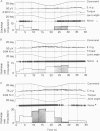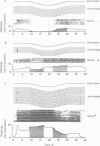Abstract
Single-unit activity was recorded with needle electrodes in eighteen muscle spindle afferents (eleven primaries, seven secondaries) from finger extensor muscles in the radial nerve of awake human subjects. The discharge rate of the afferents was determined during precisely controlled voluntary movements. The subjects performed a standardized visual ramp-and-hold tracking task, which included very slow finger extension and flexion movements (2.5 deg/s) with an amplitude of 20 deg. Throughout the tracking task a constant torque load of small or intermediate size, i.e. less than 30% of maximum voluntary contraction force, opposed finger extension. Altogether, 131 trials were studied. For most units the discharge rate was lower during shortening compared with active position holding, and it was higher during lengthening contractions. Thus, the majority of units responded to phasic stretch during the active movements, although the size of the movement response varied considerably between units and was never large. A few units even exhibited a reversed stretch response pattern. Hence, when estimated from pooled data, movement responses of the unit sample as a whole were small, around 1 impulse/s. The over-all response pattern of an individual afferent during the tracking task was very similar between successive tests. Although the discharge rate of most units increased with the load during movements as well as during position holding, the presence as well as the magnitude of movement responses depended only little on the size of the load. However, a few afferents exhibited a stretch response pattern with small loads and a reversed stretch response pattern with larger loads. In spite of the predominant increase of afferent firing during muscle lengthening there was no systematic modulation of the discharge rate in relation to the joint angle during the active movements, either in the primary or in the secondary afferents. The present findings suggest that human muscle spindles provide information about the occurrence as well as the direction of slow isotonic movements at low velocities in a precision motor task. This is in contrast to the lack of accurate position response which has previously been demonstrated.
Full text
PDF
















Images in this article
Selected References
These references are in PubMed. This may not be the complete list of references from this article.
- Bizzi E., Dev P., Morasso P., Polit A. Effect of load disturbances during centrally initiated movements. J Neurophysiol. 1978 May;41(3):542–556. doi: 10.1152/jn.1978.41.3.542. [DOI] [PubMed] [Google Scholar]
- Burgess P. R., Wei J. Y., Clark F. J., Simon J. Signaling of kinesthetic information by peripheral sensory receptors. Annu Rev Neurosci. 1982;5:171–187. doi: 10.1146/annurev.ne.05.030182.001131. [DOI] [PubMed] [Google Scholar]
- Burke D., Hagbarth K. E., Löfstedt L. Muscle spindle activity in man during shortening and lengthening contractions. J Physiol. 1978 Apr;277:131–142. doi: 10.1113/jphysiol.1978.sp012265. [DOI] [PMC free article] [PubMed] [Google Scholar]
- Burke D., Skuse N. F., Stuart D. G. The regularity of muscle spindle discharge in man. J Physiol. 1979 Jun;291:277–290. doi: 10.1113/jphysiol.1979.sp012812. [DOI] [PMC free article] [PubMed] [Google Scholar]
- CRITCHLOW V., VON EULER INTERCOSTAL MUSCLE SPINDLE ACTIVITY AND ITS GAMMA MOTOR CONTROL. J Physiol. 1963 Oct;168:820–847. doi: 10.1113/jphysiol.1963.sp007225. [DOI] [PMC free article] [PubMed] [Google Scholar]
- Cheney P. D., Preston J. B. Classification and response characteristics of muscle spindle afferents in the primate. J Neurophysiol. 1976 Jan;39(1):1–8. doi: 10.1152/jn.1976.39.1.1. [DOI] [PubMed] [Google Scholar]
- Cody F. W., Harrison L. M., Taylor A. Analysis of activity of muscle spindles of the jaw-closing muscles during normal movements in the cat. J Physiol. 1975 Dec;253(2):565–582. doi: 10.1113/jphysiol.1975.sp011207. [DOI] [PMC free article] [PubMed] [Google Scholar]
- Gandevia S. C., Hall L. A., McCloskey D. I., Potter E. K. Proprioceptive sensation at the terminal joint of the middle finger. J Physiol. 1983 Feb;335:507–517. doi: 10.1113/jphysiol.1983.sp014547. [DOI] [PMC free article] [PubMed] [Google Scholar]
- Goodwin G. M., Luschei E. S. Discharge of spindle afferents from jaw-closing muscles during chewing in alert monkeys. J Neurophysiol. 1975 May;38(3):560–571. doi: 10.1152/jn.1975.38.3.560. [DOI] [PubMed] [Google Scholar]
- Goodwin G. M., McCloskey D. I., Matthews P. B. The contribution of muscle afferents to kinaesthesia shown by vibration induced illusions of movement and by the effects of paralysing joint afferents. Brain. 1972;95(4):705–748. doi: 10.1093/brain/95.4.705. [DOI] [PubMed] [Google Scholar]
- Hagbarth K. E., Wallen G., Löfstedt L. Muscle spindle activity in man during voluntary fast alternating movements. J Neurol Neurosurg Psychiatry. 1975 Jul;38(7):625–635. doi: 10.1136/jnnp.38.7.625. [DOI] [PMC free article] [PubMed] [Google Scholar]
- Hall L. A., McCloskey D. I. Detections of movements imposed on finger, elbow and shoulder joints. J Physiol. 1983 Feb;335:519–533. doi: 10.1113/jphysiol.1983.sp014548. [DOI] [PMC free article] [PubMed] [Google Scholar]
- Horch K. W., Clark F. J., Burgess P. R. Awareness of knee joint angle under static conditions. J Neurophysiol. 1975 Nov;38(6):1436–1447. doi: 10.1152/jn.1975.38.6.1436. [DOI] [PubMed] [Google Scholar]
- Hulliger M., Nordh E., Vallbo A. B. The absence of position response in spindle afferent units from human finger muscles during accurate position holding. J Physiol. 1982 Jan;322:167–179. doi: 10.1113/jphysiol.1982.sp014030. [DOI] [PMC free article] [PubMed] [Google Scholar]
- Hulliger M., Vallbo A. B. The responses of muscle spindle afferents during voluntary tracking movements in man. Load dependent servo assistance? Brain Res. 1979 Apr 27;166(2):401–404. doi: 10.1016/0006-8993(79)90227-0. [DOI] [PubMed] [Google Scholar]
- Larson C. R., Finocchio D. V., Smith A., Luschei E. S. Jaw muscle afferent firing during an isotonic jaw-positioning task in the monkey. J Neurophysiol. 1983 Jul;50(1):61–73. doi: 10.1152/jn.1983.50.1.61. [DOI] [PubMed] [Google Scholar]
- Loeb G. E., Duysens J. Activity patterns in individual hindlimb primary and secondary muscle spindle afferents during normal movements in unrestrained cats. J Neurophysiol. 1979 Mar;42(2):420–440. doi: 10.1152/jn.1979.42.2.420. [DOI] [PubMed] [Google Scholar]
- Lund J. P., Smith A. M., Sessle B. J., Murakami T. Activity of trigeminal alpha- and gamma-motoneurons and muscle afferents during performance of a biting task. J Neurophysiol. 1979 May;42(3):710–725. doi: 10.1152/jn.1979.42.3.710. [DOI] [PubMed] [Google Scholar]
- Matsunami K., Kubota K. Muscle afferents of trigeminal mesencephalic tract nucleus and mastication in chronic monkeys. Jpn J Physiol. 1972 Oct;22(5):545–555. doi: 10.2170/jjphysiol.22.545. [DOI] [PubMed] [Google Scholar]
- Matthews P. B. Where does Sherrington's "muscular sense" originate? Muscles, joints, corollary discharges? Annu Rev Neurosci. 1982;5:189–218. doi: 10.1146/annurev.ne.05.030182.001201. [DOI] [PubMed] [Google Scholar]
- McCloskey D. I. Kinesthetic sensibility. Physiol Rev. 1978 Oct;58(4):763–820. doi: 10.1152/physrev.1978.58.4.763. [DOI] [PubMed] [Google Scholar]
- Meyer-Lohmann J., Riebold W., Robrecht D. Mechanical influence of the extrafusal muscle on the static behaviour of deefferented primary muscle spindle endings in cat. Pflugers Arch. 1974;352(3):267–278. doi: 10.1007/BF00590491. [DOI] [PubMed] [Google Scholar]
- Nordh E., Hulliger M., Vallbo A. B. The variability of inter-spike intervals of human spindle afferents in relaxed muscles. Brain Res. 1983 Jul 18;271(1):89–99. doi: 10.1016/0006-8993(83)91367-7. [DOI] [PubMed] [Google Scholar]
- Phillips C. G. The Ferrier lecture, 1968. Motor apparatus of the baboon's hand. Proc R Soc Lond B Biol Sci. 1969 May 20;173(1031):141–174. doi: 10.1098/rspb.1969.0044. [DOI] [PubMed] [Google Scholar]
- Prochazka A. Muscle spindle function during normal movement. Int Rev Physiol. 1981;25:47–90. [PubMed] [Google Scholar]
- Prochazka A., Stephens J. A., Wand P. Muscle spindle discharge in normal and obstructed movements. J Physiol. 1979 Feb;287:57–66. doi: 10.1113/jphysiol.1979.sp012645. [DOI] [PMC free article] [PubMed] [Google Scholar]
- Rothwell J. C., Traub M. M., Day B. L., Obeso J. A., Thomas P. K., Marsden C. D. Manual motor performance in a deafferented man. Brain. 1982 Sep;105(Pt 3):515–542. doi: 10.1093/brain/105.3.515. [DOI] [PubMed] [Google Scholar]
- SEARS T. A. EFFERENT DISCHARGES IN ALPHA AND FUSIMOTOR FIBRES OF INTERCOSTAL NERVES OF THE CAT. J Physiol. 1964 Nov;174:295–315. doi: 10.1113/jphysiol.1964.sp007488. [DOI] [PMC free article] [PubMed] [Google Scholar]
- Sanes J. N., Evarts E. V. Motor psychophysics. Hum Neurobiol. 1984;2(4):217–225. [PubMed] [Google Scholar]
- Taylor A., Cody F. W. Jaw muscle spindle activity in the cat during normal movements of eating and drinking. Brain Res. 1974 May 17;71(2-3):523–530. doi: 10.1016/0006-8993(74)90996-2. [DOI] [PubMed] [Google Scholar]
- Vallbo A. B., Hagbarth K. E. Activity from skin mechanoreceptors recorded percutaneously in awake human subjects. Exp Neurol. 1968 Jul;21(3):270–289. doi: 10.1016/0014-4886(68)90041-1. [DOI] [PubMed] [Google Scholar]
- Vallbo A. B., Hulliger M. The dependence of discharge rate of spindle afferent units on the size of the load during isotonic position holding in man. Brain Res. 1982 Apr 15;237(2):297–307. doi: 10.1016/0006-8993(82)90443-7. [DOI] [PubMed] [Google Scholar]
- Vallbo A. B. Impulse patterns in a muscle nerve during voluntary contraction in man. Acta Physiol Scand. 1967 Jan-Feb;69(1):123–124. doi: 10.1111/j.1748-1716.1967.tb03499.x. [DOI] [PubMed] [Google Scholar]
- Windhorst U., Schmidt J., Meyer-Lohmann J. Analysis of the dynamic responses of deefferented primary muscle spindle endings to ramp stretch. Pflugers Arch. 1976 Nov 5;366(2-3):233–240. doi: 10.1007/BF00585883. [DOI] [PubMed] [Google Scholar]








